Puts Column 50-60 mm Leica R Lenses - Leica Camera AG
Puts Column 50-60 mm Leica R Lenses - Leica Camera AG
Puts Column 50-60 mm Leica R Lenses - Leica Camera AG
Create successful ePaper yourself
Turn your PDF publications into a flip-book with our unique Google optimized e-Paper software.
<strong>Leica</strong> R-<strong>Lenses</strong><br />
by Erwin <strong>Puts</strong><br />
August 2003<br />
Chapter 1: <strong>50</strong> <strong>mm</strong> and <strong>60</strong> <strong>mm</strong> lenses<br />
__ LEICA SUMMICRON-R <strong>50</strong> <strong>mm</strong> f/2<br />
__ LEICA MACRO-ELMARIT-R <strong>60</strong> <strong>mm</strong> f/2.8<br />
__ LEICA SUMMILUX-R <strong>50</strong> <strong>mm</strong> f/1.4
Chapter 1 <strong>Leica</strong> R-<strong>Lenses</strong> 1<br />
From 1925 to 19<strong>50</strong>, the lens with a focal length of <strong>50</strong><strong>mm</strong> was<br />
the most used standard lens. Much has been written about the<br />
diagonal of the film format being the dsetermining value for its<br />
definition as the ‘standard lens’. The length of the diagonal of<br />
the 35<strong>mm</strong>-format is 43<strong>mm</strong> (to be precise: 43.27<strong>mm</strong>) and therefore<br />
this should actually be its focal length. In fact any focal<br />
length from 43 to 58<strong>mm</strong> has been used for the standard lens.<br />
More importnat from my point of view are the perspective and<br />
angle of view that one gets with a <strong>50</strong><strong>mm</strong> lens. When Prof. Berek<br />
was calculating the first <strong>50</strong><strong>mm</strong> lens for the new <strong>Leica</strong> format as<br />
it was known in those days, he was without doubt searching for<br />
a balanced compromise between useability, speed, depth-offield,<br />
and optical performance. In addition, the lens should<br />
exploit all capabilities of the somewhat unorthodox image size<br />
that Barnack had chosen. The aspect ratio of 2:3 (1: 1.5) was<br />
known from the then ubiquitous 6x9cm print size, but most<br />
paper sizes had an aspect ratio between 1:1.25 und 1:1.38. The<br />
"golden section”, i.e. the ideal proportion as used by painters,<br />
had an aspect ratio of 1:1.62, slightly more than Barnack’s format.<br />
__Artistic considerations<br />
The <strong>Leica</strong> was intentionally designed as a camera to be used in<br />
an upright posiion and in front of the eye. The maximum viewing<br />
angle of humans is limited to 140 degrees in the vertical<br />
direction and 200 degrees in the horizontal position. And this<br />
ratio (1:1.43) is quite close to the ratio of the Barnack negative<br />
size. What you can intuitively observe with your eyes, can be<br />
captured almost identically on the negative. A small trick: when<br />
you observe the scene with squinted eyes you will see a blurred<br />
picture, but the outlines of subjects and their distribution over<br />
the image area can be detected with ease. This helps to find a<br />
good or interesting composition. The viewing angle of 47<br />
degrees and the perspective (meaning the relationship between<br />
the size of the depicted objects at the different distances) of<br />
the <strong>50</strong><strong>mm</strong> lens supports the correct reproduction of the intuitive<br />
observations on the final print. The first generation of <strong>Leica</strong><br />
photographers almost exclusively employed the <strong>50</strong><strong>mm</strong> lens,<br />
evan after the introduction of interchangeable lenses. And with<br />
this lens, often stopped down to 1:8, photographic masterpieces<br />
have been created. A picture originates between the ears,<br />
but one needs an instrument that can capture the scene on film<br />
exactly as it was experienced. The ‘<strong>50</strong><strong>mm</strong>’ has much more<br />
potential than is often believed.<br />
In recent times it has gotten a bit quiet around the normal lens.<br />
You will quite often hear that the focal length 35<strong>mm</strong> represents<br />
the natural perspective in a more pleasing way. In part this is<br />
just a matter of taste or opinion. Every picture has a main motive<br />
and some environment surrounding the subject. Or in other<br />
words: a foreground and a background. In photographic composition<br />
the size relation between main subject and background is<br />
quite important. If you look closely at pictures, you will often<br />
find that the picture taken with a 35<strong>mm</strong> lens is a bit tense and<br />
intrusive, because of the prominent position of the main subject<br />
in the focus of attention.<br />
The ‘<strong>50</strong><strong>mm</strong>’ is a bit more balanced in its representaion of bakkground<br />
and foreground and the size relations are often harmoniously<br />
proportioned. Both perspectives are valid and one<br />
needs to understand the subtle visual differences, as this helps<br />
you to make the right decision for the selection of a lens.<br />
__Optical considerations<br />
The optical evolution normally proceeds in a smooth and orderly<br />
way, but sometimes we note an unexpected jump. The first<br />
theories about aberrations were developed by mathematicians<br />
and practical experience was gathered by makers of telescopes<br />
and microscopes. It is therefore logical that maximum resolution<br />
is a very important quality criterion. You will not be happy<br />
when the distinct spot in the sky is not a star but a double star!<br />
The optical designers tried to correct the aberrations in such a<br />
way that the resulting image point (the spot) was as small as<br />
possible. Often this meant that the small spot was surrounded<br />
by a larger area of halo or flare that reduced contrast. In those<br />
days that was the least of problems. Already in 1936, Dr. Fricke,<br />
Leitz Wetzlar, argued that edge sharpness was more important<br />
than resolution. MTF measurements were not yet invented, but<br />
his discourse pointed in that direction. In the fifties, TV became<br />
a co<strong>mm</strong>odity. There was considerable research to match the<br />
quality of the TV image to that of the 8<strong>mm</strong> movie format. The<br />
TV image however is restricted to 625 lines in the vertical<br />
direction and more resolution cannot be realized than is possible<br />
with these TV screen limitations.(this is identical to the current<br />
dicussion about pixel size and number in comparison to<br />
film emulsions. History repeats itself!).<br />
Dr. Schade was the first person who discovered that an improvement<br />
in contrast was the cause of a visually enhanced sharpness<br />
impression, even with identical or lower resolution. This<br />
knowledge, first employed in the TV design in America, has<br />
been adopted by Dr. Mandler, Leitz-Midland, when he designed<br />
the first Su<strong>mm</strong>icron-R <strong>50</strong><strong>mm</strong> f/2, introduced in 1964 together<br />
with the new <strong>Leica</strong>flex. This lens had a very high contrast and<br />
image quality judged by the then accepted standards. The high<br />
level of contrast was coupled in a smart way to a high level of<br />
resolution and for a long period, because of its excellence in<br />
terms of the micro-contrast at the limit of useable resolution,<br />
this lens served as the reference lens for tests of film emulsions.<br />
If you are engaged in collecting <strong>Leica</strong> lenses, this one<br />
should be in your collection as a significant milestone in lens<br />
design. Since then, <strong>Leica</strong> designers have always been engaged<br />
in optimizing, which is not the same as maximizing, contrast<br />
and resolution at full aperture.
__Aberrations<br />
Chapter 1 <strong>Leica</strong> R-<strong>Lenses</strong> 2<br />
You can imagine that a scene is made up of many small patches<br />
with different brightness. Their distribution is the basis for a<br />
good composition and may be used to find an interesting composition.<br />
At the moment we are only interested in the fact that<br />
the lens should reproduce these brightness spots faithfully.<br />
Even the smallest image point must have some extension and<br />
therefore a certain amount of energy as the light quanta are<br />
themselves energy particles. The light rays of on object point<br />
fall on the surface of a lens and are refracted by the spherical<br />
form of the surface to form an image point as small as possible.<br />
These image points on the negative are very small (typically<br />
0.005<strong>mm</strong> in diameter). If you look at such a point very closely,<br />
you will note that it consists of a very small bright core where<br />
most of the light rays are focused, and a larger circle around<br />
the core where the rest of the rays will fall. This is a rim caused<br />
by flare. If we have a very small core and a large area around<br />
the core, we have maximum resolution but contrast will be very<br />
low. You can reduce the circle of flare around the core, with the<br />
effect that more rays will be concentrated in that core, but we<br />
now need a larger area for more rays. Now contrast is at optimum,<br />
but resolution is slightly less (see illustration below).<br />
The designer has clearly some influence on the shape and composition<br />
of this image point. He/she can try to find a certain<br />
compromise between between both extremes and nudge the<br />
design in a certain direction. The residual aberrations that are<br />
always present, because of the fact that the optical errors cannot<br />
be reduced to zero, will influence the final image quality.<br />
Object points that are on or close to the optical axis will be<br />
represented as circular image points and are relatively easy to<br />
correct. That is why a good image quality in the center of the<br />
image field is not so difficult to achieve provided you restrict<br />
yourself to small apertures. When the maximum aperture is<br />
quite large, say f/2 or f/1.4, it is no longer a simple task to get<br />
Image point A Image point B<br />
good quality in the center. If you go to positions away from the<br />
axis, the distance from image point to optical axis (image<br />
height) will increase and the rays will fall obliquely on the image<br />
plane (angle of entrance). Now we will encounter new types of<br />
aberrations like astigmatism and coma that are quite difficult to<br />
correct. And some of these aberrations will, depending on<br />
image height and entrance angle, increase disproportionally in<br />
magnitude. As an example we may use spherical aberration. If<br />
we increase the aperture from f/2.8 to f/1.4, the magnitude of<br />
error increases ninefold.<br />
To complicate matters, we know that we can only correct a lens<br />
optimally for a certain distance or magification. Mostly we use<br />
the infinity distance as the reference, but for macro lenses<br />
another distance should be selected. The image quality cannot<br />
be evenly distributed over all distances, over the whole image<br />
field and at all apertures. And the wider the aperture, the more<br />
difficult it will be to find a satisfactory balance of error correction.<br />
And finally we have to face the chromatic aberrations. It is<br />
well-known that every color is refracted in an optical system by<br />
a different amount (dispersion). This means that every color<br />
(red, blue, green and so on) will have its own optimal sharpness<br />
plane and that all colors will be seen with differences in sharpness.<br />
This so called longitudinal chromatic aberration must be<br />
taken into consideration when you are searching for a compromise<br />
between highest contrast and resolution of small textural<br />
details.<br />
These facts may illustrate that any lens is always a compromise<br />
solution between many and often conflicting characteristics<br />
decided upon by humans. Even the best computer program can<br />
produce only numerical indications for this balancing. At the<br />
end of the day the optical designer has to make the final decisions.<br />
The three standard lenses in the <strong>Leica</strong> R-system therefore<br />
offer a different set of capabilities and performances.
Chapter 1 <strong>Leica</strong> R-<strong>Lenses</strong> 3<br />
__Three standard lenses<br />
At this moment there are three lenses in the lens line-up that may be designated as standard or normal lenses:the Su<strong>mm</strong>ilux-R<br />
<strong>50</strong><strong>mm</strong> f/1.4 (1998), the Su<strong>mm</strong>icron-R <strong>50</strong><strong>mm</strong> f/2 (1976) and the Macro-Elmarit-R <strong>60</strong><strong>mm</strong> f/2.8 (1972). There are good reasons to<br />
classify this last lens as a special lens for macro purposes. I would rather see this one as a very interesting standard lens with some<br />
remarkable properties.<br />
The current Su<strong>mm</strong>icron-R is almost identical in optical construction<br />
with its counterpart in the M-system. It is one of the<br />
two or three best standard lenses in the world. The predecessor<br />
from 1964 was balanced for high contrast at wide openings.<br />
The disadvantage of the design was a slight shift of focus when<br />
stopping down, that resulted in the best sharpness zone shifting<br />
from center to a zone outside of the center. The current<br />
version is a bit less contrasty at full aperture, but performs better<br />
when stopping down, and its image quality is more evenly<br />
distributed over the whole image area. Stopped down to f/4 the<br />
lens already delivers its best performance. Over an image area<br />
with a diameter of 24<strong>mm</strong> excellent quality can be seen. Brilliance,<br />
edge sharpness and resolution smoothly work together to<br />
create images with crisp rendition and almost a 3-dimensional<br />
effect. Most objects are 3-dimensional and should, when projected<br />
onto a flat plane (paper or screen), keep these properties.<br />
Image quality falls off towards the corners, i.e. if the image quality<br />
across the whole negative area is really crucial, one should<br />
consider the Macro-Elmarit-R <strong>60</strong><strong>mm</strong> f/2.8.<br />
Wide open the 5 Lp/<strong>mm</strong> are not yet at optimum position. This<br />
can be detected in the slight softness of delineations of main<br />
subject outlines. The curve itself is a bit wavy. At an image<br />
height of 12<strong>mm</strong> the line is split in two different lines for the tangential<br />
and sagital image plane. This behaviour often indicates<br />
__ LEICA SUMMICRON-R <strong>50</strong> <strong>mm</strong> f/2<br />
the presence of astigmatism (horizonatal and vertical lines are<br />
sharp in different positions of the image plane) and coma.<br />
The fact that the curve turns upwards in the corners indicates<br />
the influence of vignetting. Especially the curve for 20 Lp/<strong>mm</strong><br />
(third group of lines in the diagram) is responsible for the<br />
somewhat soft definition of the finer image details in the outer<br />
areas of the negative.
Chapter 1 <strong>Leica</strong> R-<strong>Lenses</strong> 4<br />
At f/5.6 the performance is outstanding. The line for 40<br />
Lp/<strong>mm</strong> is now as good as that for10 Lp/<strong>mm</strong> wide open. The<br />
higher the contrast at 40 Lp/<strong>mm</strong>, the higher the clarity of the<br />
fine image details. The line for 5 Lp/<strong>mm</strong> is completely level<br />
now. The fact that the outer zones do not improve in the same<br />
way at the higher frequencies indicates the presence of residual<br />
aberrations.<br />
At f/8 you will detect a slight drop in the curve for 5 Lp/<strong>mm</strong>, as<br />
can be seen in the other curves too. This small loss of contrast<br />
indicates the influence of diffraction that starts to have effect<br />
at this small diamter of the aperture opening. Small differences<br />
should not be over-emphasized. Every lens has a tolerance<br />
range of 5% in the values of the curves. This is true for all MTFgraphs.<br />
The Su<strong>mm</strong>icron-R <strong>50</strong><strong>mm</strong> f/2 offers outstanding image quality<br />
that can hardly be improved as long as one sticks to the six elements<br />
normally employed.<br />
In complicated light conditions (contre-jour or backlighting,<br />
strong light sources that fall obliquely on the lens surface,<br />
extreme differences in subject contrast, that produce flare in<br />
the shadowy parts and specular highlights) this excellent performance<br />
is preserved. Flare and secondary reflections are<br />
minimal. Specifically with slides that can render a larger contrast<br />
range, this performance shows in really deep black shadow<br />
areas. A bit typical for the Su<strong>mm</strong>icron design is the occurrence<br />
of a hazy patch of light in the center of the image in<br />
situations where a large and bright backgound is part of the<br />
scene and can act as a light box. In this situation a small change<br />
of position can correct this phenomenon.<br />
Vignetting at the edges is visible with almost two stops at full<br />
aperture. Vignetting is not so easy to analyse as seems to be<br />
the case.With a motive that has a uniform and medium bright<br />
illumination, you will see the vignetting quite clearly. With a<br />
very bright or dark background or when there are many details<br />
in the picture, it is not so easy to detect.
Chapter 1 <strong>Leica</strong> R-<strong>Lenses</strong> 5<br />
Distortion is visible with 1% at the dges of the image area. At an<br />
image height of 12<strong>mm</strong> (the top border of the negative in normal<br />
horizontal position) the distortion is hardly detectable. The<br />
general rule says that distortion above 1 to 2% will be seen, as<br />
straight lines then visibly become slightly curved.<br />
<strong>Leica</strong> lenses are always calculated according Barnack’s famous<br />
motto: small negatives, large pictures. It is in fact a pity to to<br />
restrict yourself to color pictures on a small print. <strong>Leica</strong> images<br />
should be printed at least on A4 (24x30cm) or projected with<br />
larger magnifications. It is only then that the performance of<br />
<strong>Leica</strong> lenses can be appreciated. It is clear that fine detail is<br />
only visible when the magnification is above the threshold of<br />
human perception. Small details with a size of 0.01<strong>mm</strong> or<br />
0.005<strong>mm</strong> on the negative need a resolution of <strong>50</strong> to 100<br />
Lp/<strong>mm</strong> with good micro-contrast. In normal conditions and at a<br />
distance of 25cm the eye can discern about 3 to 6 Lp/<strong>mm</strong>. This<br />
means we need an enlargement between 8x and 32x to see the<br />
detail in the negative.<br />
Negative <strong>50</strong> Lp/<strong>mm</strong><br />
Negative 100 Lp/<strong>mm</strong><br />
Eye 3 Lp/<strong>mm</strong><br />
16x<br />
32x<br />
Eye 6 Lp/<strong>mm</strong><br />
16x<br />
At smaller print magnifications and print sizes we are unable to<br />
see the many details present in the subject and captured by our<br />
<strong>Leica</strong> lenses. The joy and pleasure in using <strong>Leica</strong> lenses could<br />
be enhanced when we exploit the quality to the full. The <strong>50</strong><strong>mm</strong><br />
lens with an aperture of f/2 can be employed universally and<br />
its full aperture can be used without restrictions. You should<br />
always strive to use the highest possible shutter speed. The old<br />
rule of thumb that the reciprocal of the focal length is the<br />
speed limit for handheld photogrpahy is not a very smart one.<br />
With a <strong>50</strong><strong>mm</strong> lens that would imply 1/<strong>60</strong> of a second, which is<br />
evidently too slow to counter the self-excited vibration of the<br />
body (heart beat). The smaller details and especially the edge<br />
sharpness will be disturbed. The overall impression of the<br />
image is soft.<br />
There is hardly a subject that cannot be photographed with<br />
good effect with a <strong>50</strong><strong>mm</strong> lens. The palette of possibilties runs<br />
from landscape to portrait, from still life to reportage. And in<br />
photographic style there are no restrictions: dynamical or constructed,<br />
spontaneous or reflective, every approch is possible.<br />
You can do more with a <strong>50</strong><strong>mm</strong> than is often assumed. And as<br />
noted in the introduction, the perspective is natural and<br />
relaxed. Artistically the <strong>50</strong><strong>mm</strong> is a challenge to use. The 35<strong>mm</strong><br />
format with its 1:1.5 aspect ratio is a bit to wide for most compositions.<br />
You need to carefully position the main subjects and<br />
secondary subjects in a good foreground-background realtion<br />
to get a fine composition.<br />
8x
Chapter 1 <strong>Leica</strong> R-<strong>Lenses</strong> 6<br />
It is often an advantage to use a lens with an aperture that is as<br />
large as possible, as with the Su<strong>mm</strong>ilux-R. The added value of<br />
such a lens should be carefully considered. Depth-of-field is<br />
very small and when you enlarge, the depth-of-field is reduced<br />
again. The tables for the depth-of-field are based on a circle of<br />
confusion of 0.033<strong>mm</strong>, which is too large in many situations for<br />
critical work.<br />
Here a trick can help: if you wish to enlarge or project substantially<br />
larger, you can find the real depth-of-field according to<br />
this rule: Aperture on the lens used is f/8. The depth-of-field is<br />
now read off the table at the f/4 line for big enlargements and<br />
at the f/5.6 linefor smaller enlargements. This rule works also<br />
for the close-up capabilities of the Macro-Elmarit-R <strong>60</strong><strong>mm</strong><br />
f/2.8.<br />
__ LEICA MACRO-ELMARIT-R <strong>60</strong> <strong>mm</strong> f/2.8<br />
This lens is often characterized as a true macro lens. You<br />
should see this designation in a wider perspective. The ‘Macro’<br />
in the designation does not imply that the lens is calculated for<br />
very close distances and high magnifications. The macro range<br />
is normally described as the magnification range from 1:1.0 to<br />
1:<strong>50</strong>.0 or with distances from 1000<strong>mm</strong> to 10<strong>mm</strong>. Actually, the<br />
Macro-Elmarit should be designated as a close-range Elmarit.<br />
Normally a lens is calculated for optical infinity, that is a distance<br />
equal to <strong>50</strong>0 to 1000 x the focal length. It is logical that at<br />
closer distances the optical performance will drop a bit, as the<br />
aberrations are not corrected fully in this range. Partly you can<br />
compensate by stopping down. And you will often read the<br />
reco<strong>mm</strong>endation to stop down the lens when you are at close<br />
range with your lens to improve the image quality. True macroscopic<br />
lenses are designed for one optimum (small) magnification<br />
or distance range. The Macro-Elmarit-R has been designed<br />
and corrected for the medium distances in order to provide for<br />
excellent performance at infinity. The diagrams show quite<br />
good MTF values at the infinity position and especially at<br />
medium apertures the performance is better than with the<br />
Su<strong>mm</strong>icron-R.
Chapter 1 <strong>Leica</strong> R-<strong>Lenses</strong> 7<br />
At aperture f/2.8 the line for 5 Lp/<strong>mm</strong> is already located quite<br />
high and straight. The 10 and 20 Lp/<strong>mm</strong> are on the low side<br />
and you will note that medium fine detail will be outlined with<br />
faintly soft edges.<br />
At aperture f/5.6 the correction of the aberrations is excellent.<br />
The 5 and 10 Lp/<strong>mm</strong> are very high and indicate very high contrast<br />
and good resolution. The 40 Lp/<strong>mm</strong> curve drops a bit<br />
from center to corner. But one should be careful here. These<br />
very small image details are not so sensitive to small differences<br />
in contrast as the subject outlines.<br />
At aperture f/8 you will see (as with the Su<strong>mm</strong>icron-R <strong>50</strong><strong>mm</strong><br />
f/2) the effect of diffraction. The contrast drops a bit. Again a<br />
remark: these effects can be calculated and shown in a diagram:<br />
it is not so easy to detect this in real photographic practice.
Chapter 1 <strong>Leica</strong> R-<strong>Lenses</strong> 8<br />
The Macro-Elmarit-R <strong>60</strong><strong>mm</strong> f/2.8 has no distortion and the performance<br />
is equally good from center to edge.<br />
If you are looking for a standard lens that delivers superior performance<br />
at medium apertures and distances, then the Macro-<br />
Elmarit-R is frst choice. This quality can be exploited best when<br />
using a tripod or working with high shutter speeds. And (often<br />
overlooked) the subject matter must have those fine textural<br />
details, after all, the lens cannot capture what is not available.<br />
In the close-up range, between 70cm and 20cm, there is a<br />
fascinating world to explore, if you are open-eyed and wish to<br />
see new patterns in ordinary subjects. In this range the optical<br />
quality is outstandingly good. A small drop in contrast cannot<br />
be avoided, but can be accepted as the textural details are already<br />
captured quite clearly. Objects with a considerable depth<br />
should be photographed with quite small apertures and whenever<br />
possible with some backlighting to preserve the sense of<br />
depth. At a magnification of 1:10 the depth-of-field at f/5.6 is a<br />
mere 4cm. It is advantageous that the unsharpness gradient is<br />
quite smooth: unsharp detail will retain its shape and can be<br />
easily recognized. Flare cannot be detected and vignetting is<br />
quite small .<br />
The diagram shows a smooth curve, which helps to lessen the<br />
effect of vignetting. If absolutely even illumination is required,<br />
an aperture of smaller than f/5.6 should be used where the<br />
limit of natural vignetting is reached.<br />
The big advantage of this type of lens is the possibility to change<br />
quickly and smoothly from close-up to medium distances.<br />
Detail pictures and overviews can be made in one sweep from<br />
infinity to magnification 1:2. The slightly smaller angle of view<br />
of 39 degrees (compared to 47 degrees with the <strong>50</strong><strong>mm</strong>)<br />
assists in isolating the main subject. The Macro-Elmarit-R is a<br />
general purpose lens and can be used with all subjects and<br />
most photographic conditions. It is not a true reportage lens, as<br />
the long focusing movement is a bit slow when you need to go<br />
from close-up to long distance. But in all situations where the<br />
documentary and meditative style of photography is selected,<br />
this lens is the best choice.
Chapter 1 <strong>Leica</strong> R-<strong>Lenses</strong> 9<br />
The jump from 2.8 to 1.4 brings a fourfold increase in the<br />
amount of light energy that travels through the optical system.<br />
And some aberrations grow in magnitude by a factor of nine.<br />
Specifically the spherical aberration and the chromatic variation<br />
of spherical aberration and coma are nasty funspoilers. You<br />
can not eliminate these errors, only compensate them with<br />
other aberrations. That is why a truly outstanding 1.4-lens is so<br />
difficult to design.<br />
The first version of the Su<strong>mm</strong>ilux-R <strong>50</strong><strong>mm</strong> f/1.4 from 1970 had<br />
co<strong>mm</strong>endable performance and was as good as the rest of the<br />
competition. It was not better though, and one should reflect on<br />
the fact that in those days a 1.4-lens was a must for every<br />
manufacturer in the front rank of optical design. Wide open the<br />
image was soft and with low contrast. Stopped down the quality<br />
__ LEICA SUMMILUX-R <strong>50</strong> <strong>mm</strong> f/1.4<br />
improved, but the lens never reached the performance level of<br />
the Su<strong>mm</strong>icron-R. Specifically the quality in the outer zonal<br />
areas was not very good even at f/4.<br />
The new design from 1998 with 8 elements solved these problems<br />
and more! At aperture f/1.4 the performance is very<br />
close to that of the Su<strong>mm</strong>icron-R at f/2. I write ‘almost’ as the<br />
lens shows a very faint softness under critical inspection and<br />
large magnifications. The curves for 5 and 10 Lp/<strong>mm</strong> are located<br />
a bit low and this signifies a lower overall contrast and a<br />
softness at the edges of subject outlines. The maximum resolution<br />
is not yet at its best at this aperture. You can discover this<br />
under test conditions, but generally it makes no sense to test a<br />
1.4 lens wide open for best resolution. You will not use this lens<br />
at maximum aperture to make high resolution pictures. A more<br />
relevant practical comparison is the one I made when, during a<br />
two week holiday, I used both the Su<strong>mm</strong>icron-R at aperture f/2<br />
and the Su<strong>mm</strong>ilux-R at aperture f/1.4 and f/2. During the projection<br />
of the slides it was often impossible to identify which<br />
lens was used for the pictures. We may state that for most picture<br />
taking situations the Su<strong>mm</strong>ilux-R performs as well as the<br />
Su<strong>mm</strong>icron-R at when both are set at aperture f/2 the Su<strong>mm</strong>ilux<br />
is a tad better. At aperture f/1.4 the vignetting is identical<br />
to that of the Su<strong>mm</strong>icron-R at f/2.
Chapter 1 <strong>Leica</strong> R-<strong>Lenses</strong> 10<br />
It is really fun to use this lens at aprture f/1.4. The bright<br />
image on the finder screen allows for fast and secure focusing<br />
and the resulting pictures have a special charm and character.<br />
With aperture f/1.4 under-exposure is not so very critical as<br />
the light gathering power allows the main subject detail in the<br />
shadows to have clean outlines and the specular highlights to<br />
be cleanly delineated. The fine textural details in the main subject<br />
(where the sharpness plane is located) show clarity, the<br />
colors are saturated without being on the dark side. The sum of<br />
all these characteristics creates pictures with the famous <strong>Leica</strong><br />
look.<br />
Flare in high contrast situations is very minor, but whenever<br />
possible, the built-in lens hood is a must. Tricky lighting can<br />
spoil the day. The big surprise with the Su<strong>mm</strong>ilux-R is the<br />
remarkably high image quality when stopping down. This is not<br />
an obvious result. You buy a lens not only for its wide open performance,<br />
but want to use it also at smaller apertures with<br />
equally good or better results. Especially the improvement of<br />
the performance in the area outside the center of the image is<br />
very high.<br />
At aperture f/2.8 the Su<strong>mm</strong>ilux-R equals the Su<strong>mm</strong>icron at<br />
aperture f/5.6. Especially the location of the curve for 5<br />
Lp/<strong>mm</strong> indicates a very high image contrast. Very fine details<br />
in the edges are still weak and blurred. Look at the curve for 40<br />
Lp/<strong>mm</strong> beyond an image height of 15<strong>mm</strong>. The rapid increase in<br />
performance when stopping down indicates a low level of residual<br />
aberrations, specifically the chromatic aberrations.<br />
At f/5.6 the Su<strong>mm</strong>ilux is so good that you need the best films<br />
to realize the image potential.
Chapter 1 <strong>Leica</strong> R-<strong>Lenses</strong> 11<br />
The curves for 5, 10 and 20 Lp/<strong>mm</strong> are almost flat, close together,<br />
and high in the diagram. The small undulation in the curve<br />
for 40 Lp/<strong>mm</strong> is not so important in this case. You can be very<br />
happy with this performance potential. An ideal lens is not (yet)<br />
possible. The excellent performance wide open is accompanied<br />
by some distortion.<br />
Close to 2% is still an impressive value, but one will see this clearly<br />
as straight lines as the edges become a bit curved. You<br />
should reflect on this behaviour when selecting your subject<br />
matter. I am not aware of a better <strong>50</strong><strong>mm</strong> f/1.4 lens than this<br />
one, within and without the <strong>Leica</strong> domain. There are very few<br />
lenses in the same performance league, but the <strong>Leica</strong> lens has<br />
the advantages of better mechanical engineering and precision<br />
in manufacture. Especially here, where you expect and demand<br />
top quality, the accuracy of manufacture may be quite significant.<br />
Stopped down this lens delivers outstandingly good image<br />
quality and wide open the performance is excellent, even in<br />
absolute terms. If you are aware of the great challenges that<br />
have to be taken up by the designers to create a lens with such<br />
high performance, you feel impressed by the result.<br />
__Su<strong>mm</strong>ary<br />
The Su<strong>mm</strong>ilux-R <strong>50</strong><strong>mm</strong> f/1.4most versatile and offers the best<br />
allround performance and improves upon the Su<strong>mm</strong>icron-R<br />
<strong>50</strong><strong>mm</strong> f/2 at smaller apertures. Ana dditional advantage of the<br />
Su<strong>mm</strong>ilux is its good performance at the wider apertures. If you<br />
want accurate reproduction of a wide range of subjects, also in<br />
the close focusing range, the Macro-Elmarit-R <strong>60</strong><strong>mm</strong> f/2.8 is<br />
the best choice. The Su<strong>mm</strong>icron-R <strong>50</strong><strong>mm</strong> f/2 offers many of<br />
the characteristics of both these lenses in a compact and wellhandling<br />
shape, but has to take second place in the specialized<br />
disciplines of its companions.


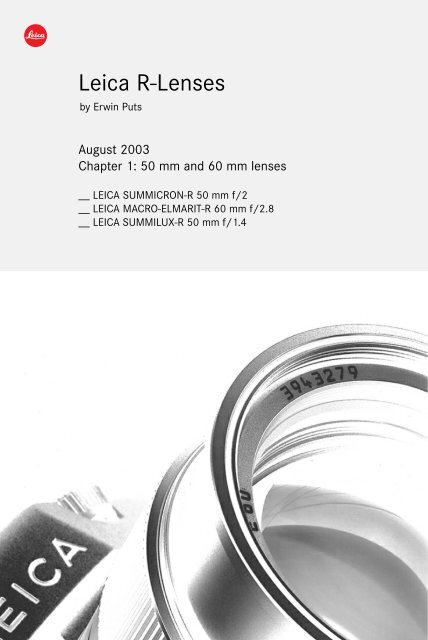



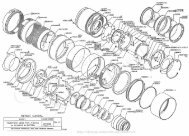



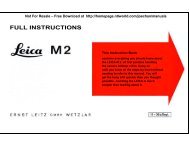
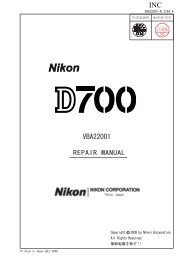
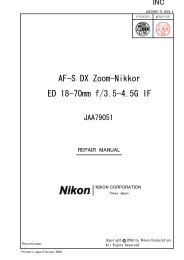
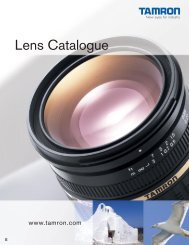

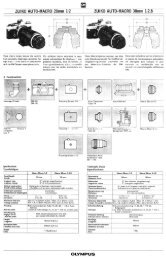

![AF 200 - 400 mm F/5.6 LD [IF] (Model 175D) - Tamron](https://img.yumpu.com/18616610/1/190x245/af-200-400-mm-f-56-ld-if-model-175d-tamron.jpg?quality=85)